2024.05.24
What is the obligation to prevent maternity harassment? An explanation from the background to the measures companies should take!
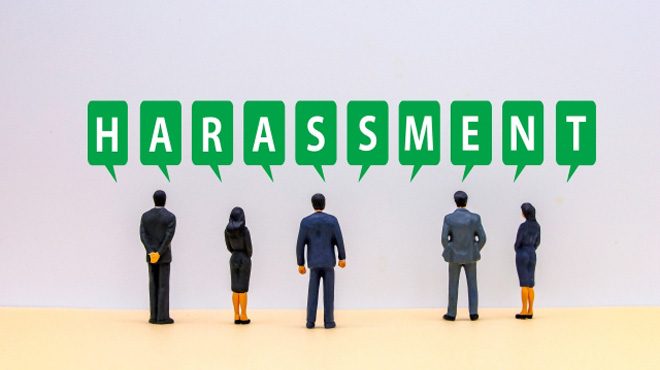
One of the important issues in promoting the improvement of the working environment and the advancement of women in society is measures against maternity harassment (hereinafter referred to as Matahara). In Japan, the "Equal Employment Opportunity Law" was revised in 2017, making it mandatory for all companies to take measures to prevent Matahara.
So, what specific measures are necessary? This time, we will focus on maternity harassment, explaining the actions companies should take and the importance of training.
1. The Reality and Types of Maternity Harassment
First, let's understand the basics of maternity harassment.
●What is Matahara?
Maternity Harassment refers to unfair treatment or harassment that female employees experience in the workplace due to pregnancy, childbirth, or the use of parental leave systems.
Let's take a look at the reality of maternity harassment.
In the past five years, a survey found that 26.3% of female workers who became pregnant or gave birth while employed reported experiencing maternity harassment. This means that approximately 1 in 4 female employees have experienced maternity harassment.
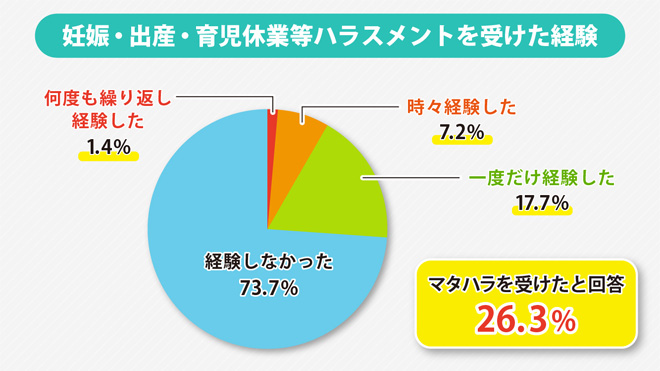
Ministry of Health, Labour and Welfare "Survey on Workplace Harassment"
Excerpt from the 2020 report, p.120, Figure 124, visualized
The content of maternity harassment actually experienced includes, overall, "requests for the use of systems, etc. by superiors or behaviors that hinder the use of systems, etc." (24.3%) being the most common, followed by "repeated or continuous harassment, etc. (harassing behavior, being prevented from engaging in work, being assigned only menial tasks)" (24.0%). It is also noteworthy that the content of harassment varies by the age of the respondents.
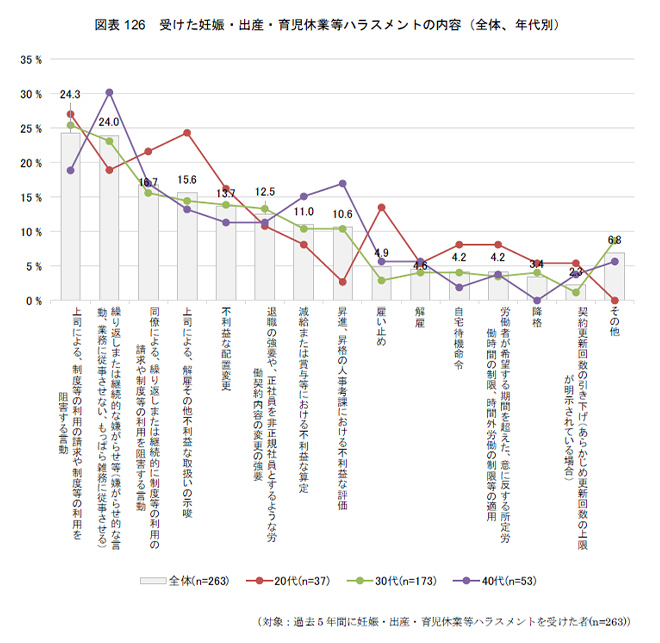
Ministry of Health, Labour and Welfare "Survey on Workplace Harassment"
Fiscal Year 2020 Report p.122 Figure 126
Such maternity harassment can be divided into two types: "harassment related to the use of maternity and childcare leave systems" and "harassment related to being pregnant or giving birth."
Types of Maternity Harassment.1: Harassment related to the use of maternity and childcare leave systems
Interfering with the use of systems and measures covered by the Equal Employment Opportunity Act and the Child Care and Family Care Leave Act, or harassing workers who utilize them. There are mainly three cases as follows.
(1) Suggestion of Dismissal or Other Disadvantageous Treatment
It refers to a situation where a supervisor suggests dismissal or other disadvantageous treatment to employees who have requested or utilized the system.
▶Specifically...
・When I consulted my boss about taking maternity leave, I was told, "If you take time off, you will have to quit."
(2) Request for Use of System or Obstruction of Use
To request the use of the system or to influence supervisors or colleagues not to request or use it against employees who have utilized it.
▶Specifically...
・When I requested parental leave, my boss said, "If you take parental leave, don't expect to be promoted."
・When I requested parental leave, a colleague said, "Don't request it because it will inconvenience others."
(3) Harassment based on the use of systems, etc.
Harassment by supervisors or colleagues towards employees who utilize systems and similar resources.
▶Specifically...
・I was told by my boss, "I cannot assign major tasks to someone who has restrictions on overtime work."
・I was told by a colleague, "Everyone is inconvenienced because of your short working hours."
Type 2 of Maternity Harassment: Harassment related to pregnancy and childbirth
The work environment is harmed by the words and actions of those around female employees who are pregnant or have given birth. There are mainly two cases.
(1) Suggestion of Dismissal or Other Disadvantageous Treatment
The supervisor suggesting dismissal or other disadvantageous treatment to female employees who are pregnant or have given birth.
▶Specifically...
・When I reported my pregnancy to my boss, I was told, "It would be better to resign soon as we will hire someone to replace you."
(2) Harassment due to Pregnancy and Childbirth
Harassment by supervisors or colleagues against female employees who have been pregnant or given birth.
▶Specifically...
・I was told by my boss, "I can't assign work to pregnant women because I don't know when they will take a break," and was made to do only menial tasks.
・A colleague told me, "If you were going to get pregnant, you should have avoided busy periods."
In addition, cases where male workers become victims are referred to as Paternity Harassment. Paternity Harassment is defined as harassment related to the use of parental leave or childcare leave systems. For example, if a man wishes to take childcare leave but is obstructed from doing so, this constitutes Paternity Harassment.
* The "Child Care and Family Care Leave Law," which is closely related to the issue of maternity harassment, is explained in detail in the blog below
>2022 Amendment to the Child Care and Family Care Leave Law: 5 Key Points Explained Clearly
2. Mandatory Measures to Prevent Maternity Harassment and Actions Companies Should Take

●What is the obligation to prevent maternity harassment?
In recent years, consultations regarding maternity harassment to labor bureaus have been on the rise. In the fiscal year 2015, the number of consultations received by labor bureaus nationwide reached 4,269, a 19% increase compared to the previous year, drawing significant attention as a major issue.
Against this background, in January 2017, it became mandatory for all companies to take measures to prevent maternity harassment due to the revision of the Equal Employment Opportunity Law for Men and Women.
●Measures companies should take to prevent maternity harassment
In response to the obligation to prevent maternity harassment, the Ministry of Health has provided the following guidelines regarding the measures that companies should take.
(Measure 1) Clarification of the Policy Against Maternal Harassment and Awareness Within the Company
We will clearly communicate to all employees that maternal harassment is not tolerated. Including specific examples of maternal harassment will help promote understanding. Additionally, it is effective to amend the employment regulations to include maternal harassment as a disciplinary reason.
(Measure 2) Establishing a system to respond to consultations regarding maternity harassment and to take appropriate actions
It is important to establish a consultation desk for maternity harassment, ensuring that the person in charge can respond appropriately based on the content and situation. Additionally, it is necessary to provide broad consultation support not only when maternity harassment has actually occurred but also in cases where there is a fear of occurrence or when it is unclear whether the situation qualifies as maternity harassment.
(Measure 3) Appropriate and Prompt Response When Maternity Harassment Occurs
When maternity harassment occurs, the first step is to conduct hearings with the victim, the perpetrator, and any witnesses to quickly and accurately confirm the facts. If the facts are confirmed, care for the victim should be provided promptly. Additionally, appropriate measures should be taken against the perpetrator. Do not forget to implement measures to prevent recurrence.
(Measure 4) Measures to Eliminate the Background Factors of Maternity Harassment
As a means to eliminate the background factors of maternity harassment, the establishment of a work system and the dissemination of various systems can be mentioned. Through these measures, it is expected to lead to smooth communication among employees and the cultivation of a consciousness of "carrying out appropriate work," thereby preventing the occurrence of maternity harassment in advance.
For example, it can be anticipated that the workload of other employees increases due to the health issues of employees who are pregnant or have given birth, resulting in harassment and other forms of maternity harassment. Therefore, it can be said that establishing a system and reviewing work distribution are effective measures against maternity harassment.
(Measure 5) Awareness of Rules Related to Privacy Protection in Relation to Maternal Harassment
Let's take necessary measures to protect the privacy of the consultants. Specifically, this may include creating a manual on privacy protection and providing training on privacy protection to the personnel who handle consultations. It is also important to inform employees that they will not suffer any disadvantages for consulting about maternal harassment or cooperating in investigations of the facts.
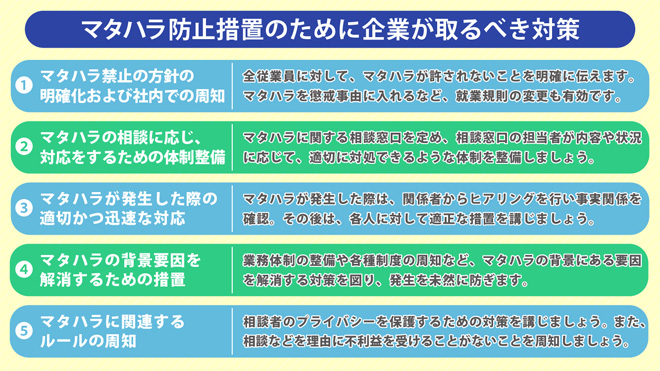
Even if measures are established to address maternity harassment, if there is no system in place for consultation or if there is a possibility of information leakage even if consultation is possible, employees will not feel secure in seeking advice. This leads to the emergence of "seeds" of maternity harassment without the issues coming to light. First and foremost, a consultation desk where employees can safely express their concerns and anxieties regarding maternity harassment is necessary.
3. The Necessity of Training on Maternity Harassment and Its Benefits

Employees who have suffered from maternity harassment may experience various physical and mental effects.
According to a survey on the physical and mental impacts of maternity harassment, the highest percentage reported feeling "anger, dissatisfaction, and anxiety" (63.2%), followed by "a decrease in motivation towards work" (47.4%) and "a reduction in communication at the workplace" (30.4%).
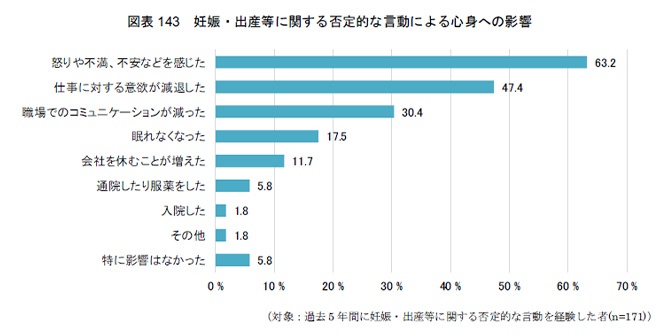
Ministry of Health, Labour and Welfare "Survey on Workplace Harassment"
Fiscal Year 2020 Report p.136 Figure 143
It is a significant risk for companies when their valuable asset, employees, suffer from health issues, which in turn disrupts business operations. Therefore, it is important for the entire organization to acquire correct knowledge about maternity harassment and to engage in conscious behavior on a daily basis.
What we recommend is the implementation of training related to maternity harassment.
The implementation of training not only contributes to knowledge acquisition and strict compliance with laws and regulations, but also offers various benefits such as improving employee health and motivation, and promoting the success of female employees. Furthermore, it can be expected to serve as an effective preventive measure, especially for managers who are in positions that are more likely to become perpetrators.
●Expected Benefits of Training on Maternity Harassment
Merit 1: Improvement of Employee Awareness
Through training, employees will gain a deeper understanding of how maternity harassment manifests in behaviors and words, as well as its seriousness and impact. Additionally, they will learn the importance of extending understanding and support to victims.
Merit.2 Improvement of Work Environment and Communication
By being aware of maternity harassment, it serves as an opportunity to reassess the existing work environment and communication among employees. As a result, it is expected to enhance employee motivation and productivity, leading to a decrease in turnover rates and an increase in employee satisfaction.
Merit.3 Promotion of Female Employee Success
Preventing maternity harassment supports the success of female employees. By creating a long-term, secure working environment, it leads to the development of female employees' careers and the demonstration of their leadership skills.
Merit.4 Risk Mitigation
When maternity harassment occurs, companies may be exposed to legal risks. By preventing maternity harassment through training, such risks can be mitigated.
In this way, training on maternity harassment can have positive effects for both companies and employees.
4. Summary

Pregnancy and childbirth are significant life events that can be joyful for those involved, but they can also trigger changes in work patterns. In such cases, if those around have an understanding and knowledge of pregnancy and childbirth, it is expected that maternity harassment can be prevented and a healthy workplace environment can be established.
Therefore, I mentioned that conducting training on maternity harassment is effective.
In particular, training utilizing e-learning is highly convenient and efficient, allowing for learning regardless of time or place.
At Human Science, we offer an e-learning material titled "STOP! Matahara - For Creating a Comfortable Workplace" that allows you to easily learn about matahara. In addition to basic knowledge about matahara, it provides clear explanations of various systems related to pregnancy and childbirth.
Furthermore, it includes practical information on where to seek advice when you experience or witness matahara.
For more details, please refer to the e-learning site of Human Science Co., Ltd.
>e-learning material "STOP! Matahara - For Creating a Comfortable Workplace"













